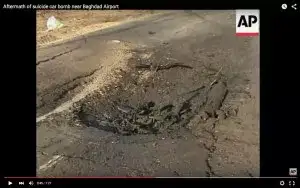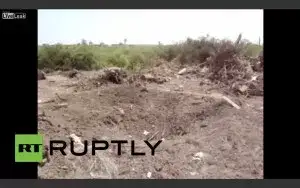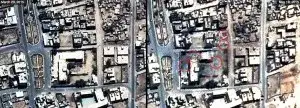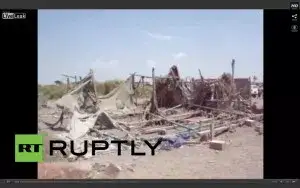Saudi Arabia announces the next phase
September 29, 2023 by Thomas Wictor
Everyone in the Middle East who cherishes freedom and peace should celebrate September 29, 2015. Today Saudi Arabia made clear that the next phase of reformation and stabilization has begun.
Syrian leader Bashar al-Assad must leave office or face being turfed out by force, Saudi foreign minister Adel Al-Jubeir says.
Mr Jubeir rejected Russian calls for an international coalition to help Mr Assad fight the Islamic State group, and said the Syrian leader’s best option would be to step down.
“There is no future for Assad in Syria, with all due respect to the Russians or anyone else,” Mr Jubeir told reporters in New York after meetings with Saudi Arabia’s allies.
“There are two options for a settlement in Syria. One option is a political process where there would be a transitional council,” he said, describing this as the “preferred option.”
“The other option is a military option, which also would end with the removal of Bashar al-Assad from power,” Mr Jubeir warned.
“This could be a more lengthy process and a more destructive process, but the choice is entirely that of Bashar al-Assad.”
Mr Jubeir would not be drawn on specifics of what a military option would look like, but noted Saudi Arabia was already supporting “moderate rebels” in their battle against Mr Assad.
“Whatever we may or may not do we’re not talking about,” he said.
In Yemen, the Arab League, Senegal, and Pakistan are using air power, armor, indigenous troops, and special forces. I’m guessing that a Saudi-led war on Syria would be much more violent, yet it would lead to a dramatic reduction in civilian casualties. Here’s what the civilian death and injury toll looks like in Yemen, according to all the news reports I’ve read.
Ansar Allah—the Houthis—have been reduced to murdering their own people to blame on the Coalition. The “air strike on a wedding party” that allegedly killed 135 people was actually a car or truck bomb. There’s a video that I won’t post because it’s just pornography. It shows mutilated corpses and body parts from the incident. The injuries prove that high-explosive aerial munitions weren’t used, but I don’t need to show you that.
Instead, watch this video of the aftermath of a vehicle-borne improvised explosive device (VBIED) in Iraq. There’s no gore.
This is the crater that the VBIED in Iraq left in asphalt.
And here’s the crater that the VBIED left in the dirt at the Yemeni “wedding party.”
I can tell that the Yemen crater didn’t come from an aerial munition because it didn’t strike a building. The Coalition is capable of surgically removing portions of structures; it doesn’t drop bombs onto empty soil.
A VBIED is used in different ways: It can bring down a building, it can create a breach in a defensive line, it can destroy a patrol, or it can be used on a crowd of civilians. That’s what happened at the Yemeni “wedding party.” The video shows people gathering up body parts from areas nowhere near the site of the explosion. An aerial munition simply lacks the power to throw dead bodies very far.
“Eyewitnesses” say that two tents were struck by aerial munitions, but there are no craters in the earth.
You’re looking at blast damage from a pressure wave that rolled horizontally across the ground. That screen grab debunks the accusation that Coalition aerial munitions caused the destruction. And so far, the Coalition has not been caught in lies.
[A] coalition spokesman vehemently denied it was behind the attack. A spokesman said: “There have been no air operations by the coalition in that area for three days. This is totally false news.”
The physical evidence exonerates the Coalition. It was a VBIED, not aerial munitions. The Houthis murdered their own people.
Now, what about this next phase that the Saudis announced today? What will it look like?
I can’t say, since the Arab League, the Gulf Cooperation Council, Pakistan, Senegal, and Israel are doing a masterful job of misdirecting, misleading, and concealing. The IDF has trained for a war that will annihilate Hezbollah. Also, the Saudis have stated that Israel will destroy Hezbollah before it attacks Iran.
But is that true?
It makes logical military sense to pick off Iran’s proxies one by one prior to overthrowing the mullahs. However, it’s clear to me that the Arab League, the Gulf Cooperation Council, Pakistan, Senegal, and Israel have the capabilities to fight them all at the same time. There are other players who will likely take part as well. On June 10, 2015, Turkey announced that it would send up to 5000 troops to a specially constructed base in Qatar.
In 2008 India signed a defense pact with Qatar, pledging to protect the Gulf state from external threats. It’s the only such agreement that India has ever entered. On February 11, 2015, Indian National Security Adviser Ajit Doval visited Qatar for discussions on further strengthening the two nations’ ties.
As I’ve mentioned before, foreign troops rehearsed massive nocturnal air assaults in the American Southwest during the summer. A US Marine in Las Vegas said that it was the Israelis and “someone else.” All four of my witnesses—three are active-duty US military—said that the helicopter gunships were fitted with extra weapons. Modern armed forces often test experimental prototypes in combat.
The ACH-47A gunship wasn’t adopted because it cost too much to maintain. However, if a nation (or nations) planned only one operation that required gunships that could lay down an enormous volume of fire, cost wouldn’t be a consideration.
I can’t make any predictions about what will happen. The new assault units of the Middle East are like nothing I’ve ever seen. It wouldn’t surprise me if Assad, Hezbollah, Iran, and the Islamic State were all attacked at the same time, since all four possess long-range missiles and/or weapons of mass destruction. They’ll have to knocked out quickly. And they will be. Israel has seen to that.
Among Israel’s clients are Muslim countries with which it does not have diplomatic ties. According to the report, in 2011 Israel sought to purchase British components to export radar systems to Pakistan, as well as electronic warfare systems, Head-up Cockpit Displays (HUD), parts for fighter jets and aircraft engines, optic target acquisition systems, components of training aircraft, and military electronic systems. In 2010, Israel applied for permits to export electronic warfare systems and HUDs with components from Britain to Pakistan. Also in 2010, Israel sought permits to supply Egypt and Morocco with Israeli electronic warfare systems and HUD systems that use British parts.
In 2009, Israel requested permits from British authorities to export to Algeria aerial observation systems, pilots’ helmets and HUDs, radar systems and communications systems for military aircraft, military navigation systems, drone components, systems to disrupt ballistic systems, airborne radar and optical target acquisition systems. Israel also sought to export to Morocco electronic warfare systems and HUDs in 2009.
In that same year, Israel asked for permits to supply components for drones to the United Arab Emirates, as well as pilots’ helmets and aerial refueling systems, ground radar, components for fighter jets, systems to disrupt missile launches, airborne radar systems, and thermal imaging and electronic warfare equipment.
Right now many Israelis don’t trust Arabs, and many Arabs think that Israel is an apartheid state. Well, the Arabs won’t attack their supplier, and an apartheid state wouldn’t sell advanced technology to people it hated. The new Middle East is already here. And you haven’t seen anything yet.





